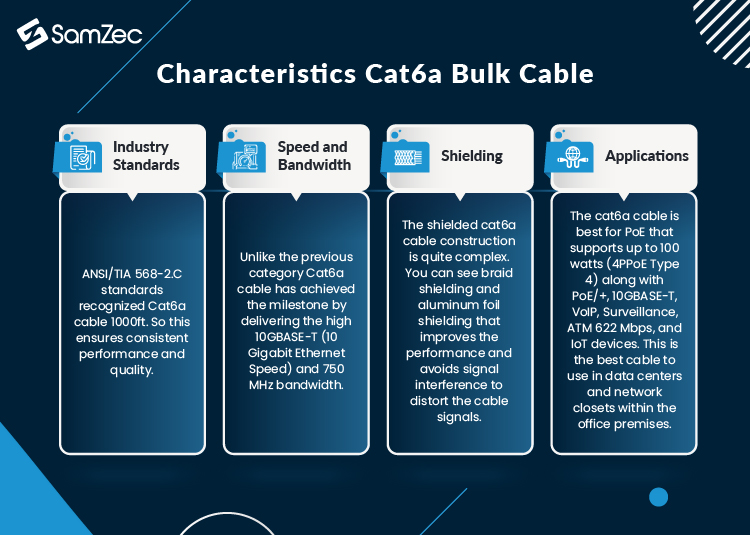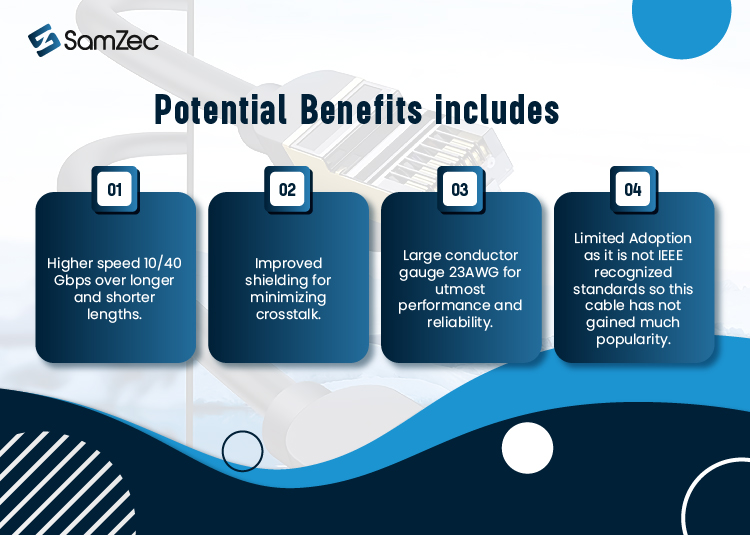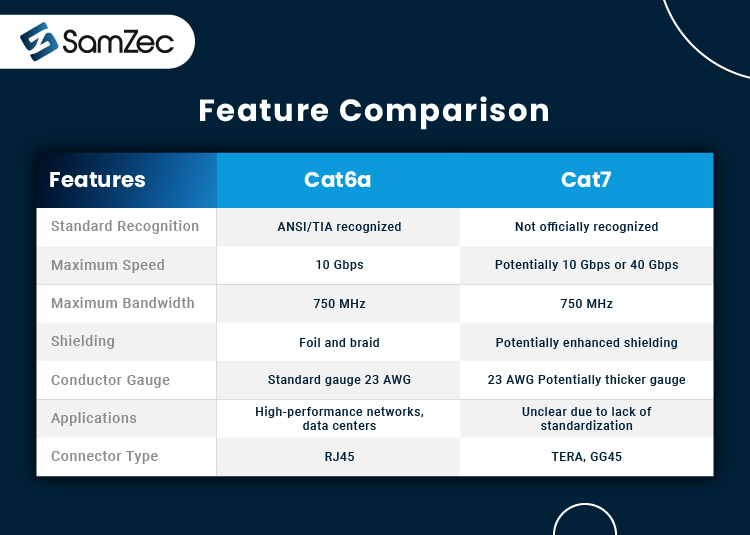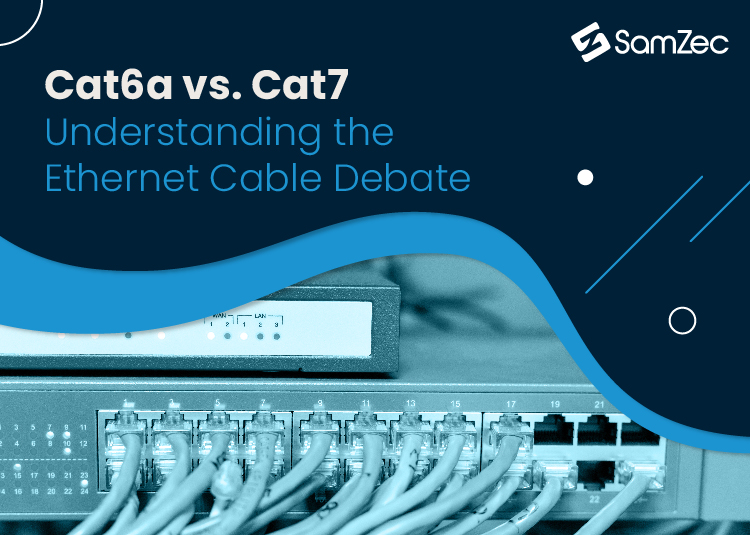Be ready to read the futuristic debate between Cat6a vs Cat7 ethernet cable. Who is the winner or both will nullify the effect due to the highly advanced features of both cables. For commercial or bulk factories Cat6a and Cat7 are used frequently but wait. Let’s read out their best possible
This blog will explain the differences between Cat6a bulk cable and Cat7 ethernet cable, do not mix this information with the patch cords (Patch Cables). So let me break down the path for you to clear your vision about these highly advanced ethernet cables Cat6a vs Cat7.
What Is Cat6A Ethernet Cable?
After the successful experiment of Category 6 ethernet cable, the electrical engineers manufactured the “Augmented Category 6 Cable” also known as Cat6a ethernet cable. If compared with its previous category cable (Cat6) the cat6a shows a stable speed of 10G at longer or shorter lengths. The highest bandwidth of 750 MHz makes it a viable choice to use it for the Fast Ethernet Applications.
The internal structure of the cable has 8 separated color-coded wires that are ideal for termination using the RJ45 connector. The key feature of the Cat6a cable is that it has a 23 AWG conductor size which is very important when you need to attain performance and functionality.

But the most confusing part is where to use this Cat6a bulk cable. Is it good for residential, commercial, or industrial use? After covering the important information regarding the Cat6a vs Cat7 cables, I will better explain this part for choosing the cable.
Characteristics Cat6a Bulk Cable
The below-mentioned characteristics of the cat6a cable will help you identify the cable capabilities regarding IEEE standards.

What Is Cat7 Ethernet Cable?
Cat7 ethernet cable is the next advanced category cable in the ethernet cable category. The cable is formally available in a shielded variant but you can also get this cable in an unshielded variant. For the cat7 ethernet cable, it is said that the cable is not recognized by ANSI/TIA or IEEE standards up till now. This statement is very critical as the cable has no guarantee of consistent performance or meets the specific requirements.
The Cat7 speed has two variations one is for longer runs “328ft” which is 10G (10 Gigabit) and when used for shorter lengths the cable ought to provide the 40 Gbps speed. The 23 AWG conductor size of the cable shows the maximum bandwidth equivalent to Cat6a.
Read More: What is a Tube Microphone?
Cat7 length for installations has also some limitations in that this cable cannot be used beyond 100 meters (328ft) also the main usage of this cable is in industrial setups and heavy factories to cope with the daily bulk transmissions. Being not recognized, will this cable still be used for installation purposes?
The cat7 ethernet cable is not backward compatible as this cable does not use RJ45 connectors instead it uses TERA or GG45 connectors for termination which vary with the size of the female RJ45 plugs.
So learn some of the basic characteristics of Cat7 ethernet cable for a clear understanding of the ethernet cable.
Key Features Of Category 7 Cable
Unofficial Cat7 Cable not affiliated with ANSI/TIA standards. But still, if you need to use this cable you can buy the necessary equipment to make reliable networking connections.

Now what you need to understand about the Cat6a vs Cat7 cable’s difference is mentioned below in the table to understand it more precisely for future reference.
Feature Comparison

When To Choose Cat6 vs Cat7 Ethernet Cable
When selecting the cables check your network speed and server speed ratings if they allow gigabit speed then choose between Cat6a vs Cat7 cable as per your ease.
Here Cat6a is budget-friendly when compared with the Cat7 cable and its features like 10/40 Gbps speed, and high insulated shielding that will not let pass the external signals. Cat7 cable features the tightly twisted pair same as the Cat6a bulk cable.
Though these cables are more powerful than previous category cables, still you cannot say that if you have 100BASE-T speed the Cat6a or Cat7 will enhance your networking speed. This is not a valid point for the ethernet cables. Instead, all these cables are just creating a bridge between hardware devices to potentially send and receive the data packets.
For High-Density Applications, Cat6a and Cat7 both are eligible but still, using cat7 is at risk due to not being recognized by ANSI/TIA. Maybe in the future, the Cat7 will become affiliated with the industry standards but up till now, there are no signs.
Which is the Ideal Jacket: Plenum Or Riser?
In simple words, both jackets are reliable and possess fire resistance capabilities to protect the cable and its internal conductors from damage. For simple and ideal while choosing Cat6 vs Cat7 cable jackets you have to remember that the location should meet the jacket ratings. Commonly there are two locations — Horizontal airy space and Vertical space within the buildings.
For choosing the cable bulk Cat7 plenum or riser all you need to fulfill the requirements of your buildings if fire safety is a major concern, use the plenum otherwise riser. The same is the case with the Cat6a plenum cable.
Plenum and riser both are indoor cables and using them outdoors will lessen the lifespan of the cable unless you will not use the extra protection (Conduit).
Final Words
Cat6a vs Cat7 are both networking giants when it comes to choosing the performance-oriented cable for your network needs. You can use cat6a cable 1000ft at your home but Cat7 cannot be used in residential spaces and also it is not backward compatible. So you need to upgrade your network equipment to install this cable.
Another factor that most consumers will consider is the pricing of both cables, installation complexity, bulkier than Cat6a, and mostly comes with S/FTP variants reducing its bending radius. Thus, the Cat7 ethernet cable challenges you to install this cable at the sharp bends of the buildings.

















